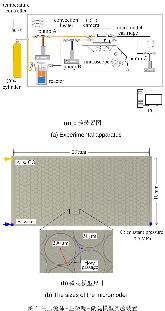Supercritical CO2 Water Displacements and CO2 Capillary Trapping: Micromodel Experiment and Numerical Simulation (in Chinese)
Abstract
We report that the CO2 capillary trapping is an important scientific issue in geological carbon sequestration, but few researches focus on the trapping mechanism at pore scale under supercritical CO2 condition. In this study, based on the high-pressure fluids-microscopy-micromodel experimental system, we performed drainage experiment, i.e. supercritical CO2 displacing water, and imbibition experiment, i.e. water displacing CO2, under the conditions of 45°C and 8.5 MPa. The DSLR camera was used to capture pictures of CO2-water two-phase immiscible flow and the microscopy was used to capture the capillary trapping behavior for the supercritical CO2 at the pore scale. The computational fluid dynamic method was adopted to simulate the two-phase fluid flow processes. The numerical results are generally in agree ment with the experimental observations, and further provide three-dimensional geometries on the interface during the drainage-imbibition processes and the trapped supercritical CO2 droplet/cluster. Lastly, the capillary trapping curve, i.e. the relationship between the initial CO2saturation and the residual saturation, was obtained from the numerical results, and we made an assessment of the three capillary trapping models, i.e. Land's, Jurauld's and Spiteri's trapping models. A comparison of the models performance indicates that Jurauld's model behaves slightly better than Land's model, whereas Spiteri's modelmore »
- Authors:
-
- Wuhan Univ. (China); Lawrence Berkeley National Lab. (LBNL), Berkeley, CA (United States)
- Wuhan Univ. (China)
- Lawrence Berkeley National Lab. (LBNL), Berkeley, CA (United States)
- Publication Date:
- Research Org.:
- Lawrence Berkeley National Lab. (LBNL), Berkeley, CA (United States)
- Sponsoring Org.:
- USDOE Office of Science (SC)
- OSTI Identifier:
- 1485063
- Grant/Contract Number:
- AC02-05CH11231
- Resource Type:
- Accepted Manuscript
- Journal Name:
- Chinese Journal of Theoretical and Applied Mechanics
- Additional Journal Information:
- Journal Volume: 49; Journal Issue: 3; Journal ID: ISSN 0459-1879
- Publisher:
- Science Press
- Country of Publication:
- United States
- Language:
- Chinese
- Subject:
- 58 GEOSCIENCES; geological carbon sequestration; micromodel; two-phase flow; numerical simulation; capillary trapping
Citation Formats
Ran, Hu, Yifeng, Chen, Jiamin, Wan, and Chuangbing, Zhou. Supercritical CO2 Water Displacements and CO2 Capillary Trapping: Micromodel Experiment and Numerical Simulation. United States: N. p., 2017.
Web. doi:10.6052/0459-1879-16-237.
Ran, Hu, Yifeng, Chen, Jiamin, Wan, & Chuangbing, Zhou. Supercritical CO2 Water Displacements and CO2 Capillary Trapping: Micromodel Experiment and Numerical Simulation. United States. https://doi.org/10.6052/0459-1879-16-237
Ran, Hu, Yifeng, Chen, Jiamin, Wan, and Chuangbing, Zhou. Thu .
"Supercritical CO2 Water Displacements and CO2 Capillary Trapping: Micromodel Experiment and Numerical Simulation". United States. https://doi.org/10.6052/0459-1879-16-237. https://www.osti.gov/servlets/purl/1485063.
@article{osti_1485063,
title = {Supercritical CO2 Water Displacements and CO2 Capillary Trapping: Micromodel Experiment and Numerical Simulation},
author = {Ran, Hu and Yifeng, Chen and Jiamin, Wan and Chuangbing, Zhou},
abstractNote = {We report that the CO2 capillary trapping is an important scientific issue in geological carbon sequestration, but few researches focus on the trapping mechanism at pore scale under supercritical CO2 condition. In this study, based on the high-pressure fluids-microscopy-micromodel experimental system, we performed drainage experiment, i.e. supercritical CO2 displacing water, and imbibition experiment, i.e. water displacing CO2, under the conditions of 45°C and 8.5 MPa. The DSLR camera was used to capture pictures of CO2-water two-phase immiscible flow and the microscopy was used to capture the capillary trapping behavior for the supercritical CO2 at the pore scale. The computational fluid dynamic method was adopted to simulate the two-phase fluid flow processes. The numerical results are generally in agree ment with the experimental observations, and further provide three-dimensional geometries on the interface during the drainage-imbibition processes and the trapped supercritical CO2 droplet/cluster. Lastly, the capillary trapping curve, i.e. the relationship between the initial CO2saturation and the residual saturation, was obtained from the numerical results, and we made an assessment of the three capillary trapping models, i.e. Land's, Jurauld's and Spiteri's trapping models. A comparison of the models performance indicates that Jurauld's model behaves slightly better than Land's model, whereas Spiteri's model behaves poorly. However, given that Land's model only contains one parameter of clear physical meaning, it is recommended for practical use.},
doi = {10.6052/0459-1879-16-237},
journal = {Chinese Journal of Theoretical and Applied Mechanics},
number = 3,
volume = 49,
place = {United States},
year = {Thu May 18 00:00:00 EDT 2017},
month = {Thu May 18 00:00:00 EDT 2017}
}
Figures / Tables:
 Fig. 1: High-pressure fluids-microscopy-micromodel system
Fig. 1: High-pressure fluids-microscopy-micromodel system

 Search WorldCat to find libraries that may hold this journal
Search WorldCat to find libraries that may hold this journal